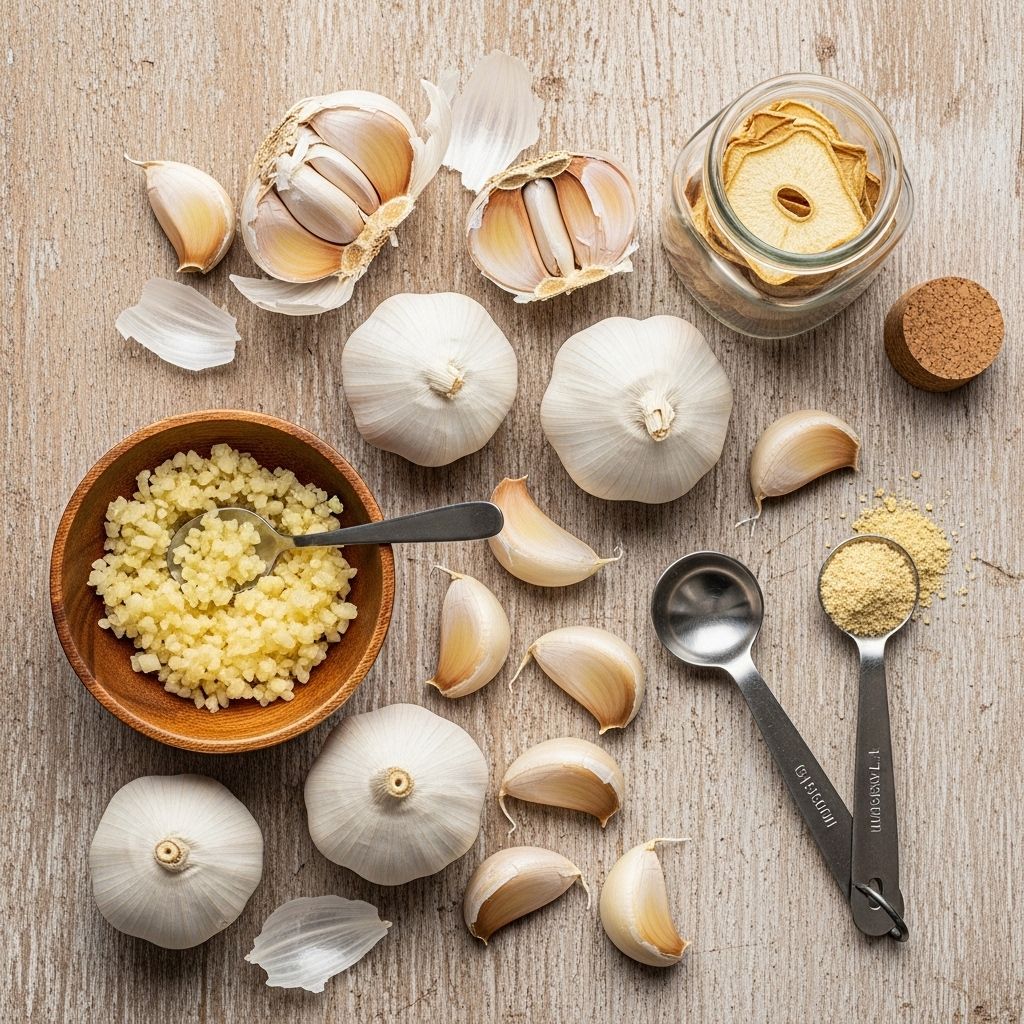Garlic Clove: Ultimate Guide To Uses, Measurements, Storage
Demystifying garlic: Learn the difference between cloves and heads, measurements, uses, storage, and more.

Image: HearthJunction Design Team
What Is a Clove of Garlic?
Garlic is a staple in kitchens worldwide, known for its pungent aroma and ability to add depth of flavor to virtually any savory dish. But when a recipe calls for a “clove” of garlic, what exactly does that mean? Understanding the distinction between the various parts of garlic, and how to work with them, is key to unlocking its culinary potential.
Clove vs. Head: Understanding the Difference
A head of garlic—also called a bulb or knob—is the entire, papery-skinned bulb sold in the produce section. When you peel away the outer layer, you’ll find several smaller, wedge-shaped segments nestled together. These are garlic cloves.
- Head of Garlic: The whole bulb, usually covered in a papery white (or purple) skin.
- Clove of Garlic: An individual segment within the head; when separated, it is ready to be peeled and used.
Cloves are easy to separate. You typically pull off just the number you need for a recipe, leaving the rest of the bulb intact for later use. Although they are small, individual cloves pack a potent punch, which is why most recipes only call for one or several at a time.
What Does a Garlic Clove Look Like?
Each clove of garlic is shaped like a small wedge or teardrop, with a papery covering that’s peeled off before use. The number of cloves in a head varies depending on the type of garlic, but each clove is usually between the size of a small almond and a grape. Cloves within the same bulb can vary in size, and some garlic varieties offer particularly large or small cloves.
How Many Cloves Are in a Head of Garlic?
The number of cloves in a head of garlic depends on the garlic variety and size:
- Standard garlic: Typically 10 to 12 cloves per head.
- Elephant garlic: A larger, milder variety with about 4 very large cloves per head.
- Specialty or hardneck garlic: Often contains 4 to 8 larger cloves per bulb.
Because clove sizes vary, use standard measurements as a guide but adjust to your taste or needs.
How Much Is a Clove of Garlic?
Cloves come in different sizes—even within the same head—so there’s no exact measurement. Generally:
- 1 small clove = about 1/2 teaspoon of minced garlic
- 1 medium clove = about 1 teaspoon of minced garlic
- 1 large clove = roughly 1.5 teaspoons of minced garlic
If your recipe calls for a clove, but you’re using pre-minced, jarred garlic, the common conversion is:
1 teaspoon pre-minced garlic = 1 garlic clove
So, for recipes calling for three cloves, you’d use three teaspoons of the pre-minced variety.
How to Substitute Garlic Forms in Cooking
Sometimes you don’t have fresh cloves on hand and reach for another form of garlic. Here’s how to substitute:
- Fresh clove to pre-minced (jarred) garlic: 1 clove = 1 teaspoon pre-minced garlic.
- Fresh clove to garlic powder: 1 clove = 1/8 teaspoon garlic powder.
- Fresh clove to garlic salt: 1 clove = 1/2 teaspoon garlic salt (reduce other salt in recipe).
Keep in mind, flavor intensity and texture vary among these forms. Fresh garlic offers a robust pungency, while powders and salts are milder and disperse differently in dishes.
How to Prepare Garlic
Garlic can be used in several forms to impart different levels of flavor:
- Whole cloves: Mild, subtle flavor—great for roasting or simmering in soups (then removed).
- Smashed cloves: Release more flavor—often used in sautés or dressings.
- Minced or grated: Intense, sharp flavor—perfect for quick-cooking dishes or raw applications.
- Crushed to a paste: Maximally pungent—adds a vibrant kick to sauces and spreads.
The smaller the pieces, the more pungent and intense the flavor will be. Sautéing, roasting, or simmering garlic in oil mellows its bite and brings out a mild sweetness.
How to Store Fresh Garlic
To keep garlic fresh and flavorful, proper storage is essential. Here are the best practices:
- Whole heads: Store in a cool, dry place with good air circulation. Avoid refrigeration if possible.
- Separated cloves (unpeeled): Store like whole heads; they last for weeks.
- Peeled cloves: Store in an airtight container in the refrigerator and use within a week.
- Chopped or minced garlic: If not using immediately, store covered in oil in the refrigerator for up to a few days—but use caution, as garlic in oil poses a risk of botulism if left at room temperature.
Signs of bad garlic include sprouting, a rubbery or dry texture, and yellow or brown discoloration. Fresh peeled garlic cloves should be white, not yellow.
Can You Freeze Garlic?
Yes, garlic can be frozen to extend its shelf life. Depending on your needs, you can freeze whole bulbs, peeled cloves, or minced garlic:
- Whole heads: Place in a freezer-safe bag, label, and freeze.
- Peeled cloves: Spread out on a parchment-lined baking sheet, cover, and freeze overnight. Then, wrap and transfer to a freezer bag.
- Minced garlic: Mince, coat with a little oil, spread on a freezer-safe sheet, freeze, then cut into cubes and store in a bag. Always freeze garlic with oil immediately to avoid risk of botulism.
Frozen garlic loses some crisp texture but retains its flavor, making it excellent for cooked dishes.
Types of Garlic: A Short Guide
There are several garlic varieties, each offering unique flavors and culinary uses:
- Hardneck garlic: Fewer, larger cloves. Stronger flavor and easier to peel.
- Softneck garlic: More, smaller cloves. Mild flavor, stores well. Most common in supermarkets.
- Elephant garlic: Technically a leek, not true garlic. Large cloves and mild, almost sweet taste.
Choosing the right garlic can subtly influence the flavor and texture of your dish.
Garlic in Recipes: How Preparation Changes Flavor
The way you prepare and cook garlic can dramatically alter its taste:
- Raw garlic: Intense, spicy, pungent flavor—use sparingly in dressings and spreads.
- Sautéed garlic: Sweetens and mellows quickly, ideal for sauces and stir-fries.
- Roasted garlic: Creamy, subtle, and slightly caramelized—great as a spread or flavor boost for vegetables and soups.
If you want just a whisper of garlic, add a smashed clove to oil, cook gently, then remove before proceeding with the rest of your recipe. For a bolder presence, mince or grate cloves to release more of their natural oils and compounds.
How to Mince Garlic: Step-by-Step
- Pull away a clove from the bulb.
- Place the clove under the flat side of a chef’s knife and give it a quick, firm smash to loosen the skin.
- Peel away the skin.
- Trim the root end.
- If mincing, use a rocking motion with your knife to chop the clove finely.
Mincing garlic finely maximizes its flavor and helps it blend seamlessly into dishes.
FAQ: Your Garlic Questions Answered
What is the difference between a garlic clove and a garlic head?
A garlic head (or bulb) is the whole, papery-covered ball you buy; a clove is one of the individual sections you separate from the head.
How do I substitute garlic powder for fresh garlic?
Use 1/8 teaspoon garlic powder for every clove of fresh garlic called for in a recipe. Adjust to taste—powder is less pungent than fresh.
Can I use pre-minced garlic instead of fresh cloves?
Yes. Substitute 1 teaspoon of pre-minced garlic for each clove. Keep in mind, the flavor is less intense and somewhat altered in jarred garlic.
How should I store garlic long-term?
Store whole garlic bulbs in a cool, dry location. For longer storage, freeze whole or minced garlic as needed.
What does bad garlic look or smell like?
Bad garlic may have sprouts, a rubbery texture, or yellow/brown spots; it might smell sour or off instead of fresh and pungent.
Quick Reference: Garlic Measurements
| Garlic Form | Equivalent to 1 Clove |
|---|---|
| Fresh minced/pressed | 1 teaspoon |
| Pre-minced (jarred) | 1 teaspoon |
| Garlic powder | 1/8 teaspoon |
| Garlic salt | 1/2 teaspoon |
Conclusion
Knowing the difference between a garlic clove and a head, how to measure and substitute garlic, and the best ways to prepare and store it, empowers you to use this essential ingredient with confidence. Whether you’re a beginner or an experienced cook, mastering garlic basics will elevate your meal’s flavor profile and add to your culinary toolkit.
References
- https://www.allrecipes.com/article/what-is-a-clove-of-garlic/
- https://www.allrecipes.com/article/we-tried-tiktok-60-garlic-clove-soup/
- https://www.allrecipes.com/article/how-to-store-garlic/
- https://www.allrecipes.com/article/types-of-garlic/
- https://www.eatingwell.com/article/8028124/what-is-a-clove-of-garlic/
Read full bio of Shinta












